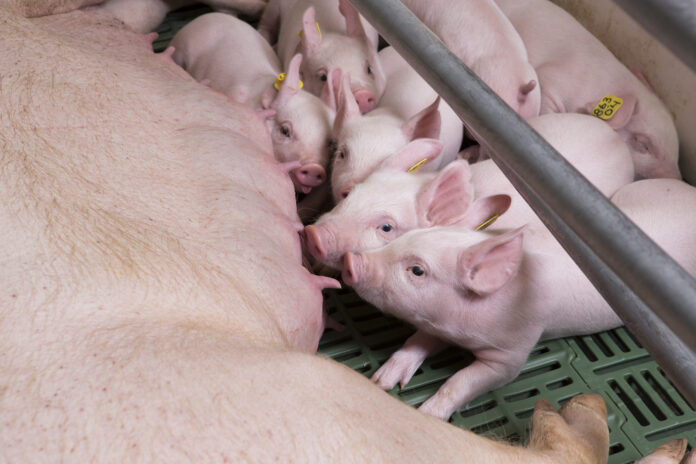By Geoff Geddes
Editor’s note: The following piece was written for Swine Innovation Porc (SIP). For more information, contact Leslie Walsh at lwalsh@swineinnovationporc.ca.

If you think that feed costs are overrated, you’re not the one paying the bill.
As piglet feeding and its impact weigh heavily on producers’ minds, science is seeking ways to make your feed dollar go further. Part of that effort involves highly relevant projects such as, ‘Towards a new feeding approach of neonatal and weanling piglets for optimizing nutritional status, immunity and microbiota, and minimizing the use of antibiotics.’
“A major focus of the project is exploring a range of approaches for maximizing the growth and health of piglets during lactation and in the pre-weaning and post-weaning periods,” said Martin Lessard, former Research Scientist, Sherbrooke Research and Development Centre (SRDC), Agriculture and Agri-Food Canada (AAFC). Lessard was a co-leader of the project with Dr. Frédéric Guay, Professor, Department of Animal Science, Laval University. After Lessard’s retirement, the project was handed over to Dominic Poulin-Laprade, a newly hired Research Scientist at SRDC-AAFC who works on pig gut microbiomes and immune systems, along with developing solutions to antimicrobial resistance in the agricultural sector.
As part of this particular project, researchers will also evaluate the potential of various feeding strategies. Specifically, they will examine bovine colostrum, naked oat, medium-chain fatty acids and yeast extracts capable of optimizing gut health through their complementary influences on microbiota and immunity.
Ideas to chew on

Lessard, and now Poulin-Laprade, and Guay hope to develop feeding strategies that will improve piglets’ robustness and resistance to infections while limiting antibiotic use – something that is now a top industry priority. If all goes as planned, they will eventually transfer ready-to-adopt practices to commercial swine producers based on scientific foundations and scaled-up demonstrations.
“The first thing we are doing for the project is testing the different feeding approaches side-by-side,” said Lessard. “We will look at colostrum alone, medium-chain fatty acids alone, a control group with neither product, one group using both products and a final group employing antibiotics.”
That final group is especially critical for industry, as the limiting of antibiotics in weaning feed means producers must find ways to compensate for the loss of that option and devise other ways of achieving those beneficial effects.
“We have just finished an experiment for testing the potential of medium-chain fatty acids, yeast extract and bovine colostrum to improve gut health by modulating host-microbiome interactions and gut immune response,” said Lessard. “Dr. Guay is now doing some other work to determine whether naked oats can improve feed intake before and after weaning, and thus intestinal physiology, including the integrity of the intestinal mucosa. He is also studying the possible role of a colostrum supplement in early lactation on post-weaning feed intake and intestinal health.”
Once they arrive at the ideal feeding conditions, researchers will repeat the experiment with medium-chain fatty acids and bovine colostrum to determine which is more effective in preventing infections. As well, they will compare results when piglets are exposed to creep feeding versus when such feeding is absent. They also plan to further scrutinize the microbiome of the animals in their study and its impact on digestibility and performance.
As is often the case with research, this project is guided in part by findings in previous studies and partly by the gaps in past research that need to be filled.
“Based on work in prior projects, it is clear that different ingredients can act on intestinal immunity, physiology and microbiota,” said Lessard. “However, few studies have investigated the combined effect of different ingredients that can act in a complementary fashion on the intestinal health of weaned piglets.”
In addition, few studies have been aimed at evaluating the effect of the composition of creep feed on pig health during the pre-and post-weaning periods.
“In the particular context of hyperprolificity, the study of pre-weaning feeding to optimize immune response, intestinal microbiota colonization and the growth of the piglets – mainly low weight – is relevant. Specifically, we want to examine this feeding under the current conditions of reduced antibiotic use and high zinc concentrations in post-weaning diets.”
According to Lessard, it is also clear that new feeding approaches with the potential to modulate gut health and piglet robustness from birth to post-weaning need to be developed and warrant closer inspection.
Clearly, the multi-pronged nature of this project promises a range of benefits for producers, with the implications for antibiotic use being one of the most notable.
Reducing antimicrobial use has wide-reaching benefits

“Through this study, we will continue to reduce the amount of antibiotics in feed, which will have a direct impact on the development of antibiotic-resistant bacteria,” said Lessard. “Using the products we are looking at here is more expensive than antibiotics, but the earlier you start with them, the better your chances of promoting long-term effects that will boost your bottom line. If pigs do well during those first six weeks of life, the benefits may be much greater than we realize right now.”
Cost is clearly a consideration for producers, and while the researchers do not yet have all the answers, they are exploring options for minimizing expenses. With bovine colostrum currently the costliest option for piglets, can the amount used be reduced from five per cent of the diet to two per cent or even one per cent by using other products that spark similar effects? Are prebiotics, nutraceuticals (pharmaceutical alternatives which claim physiological benefits) and other functional feeds a viable alternative? On their own, prebiotics and nutraceuticals may not be the most effective additive during the weaning period, but perhaps they could be added to bovine colostrum to increase the beneficial effects.
If the road to results is paved by asking the right questions, these researchers are well on their way.




